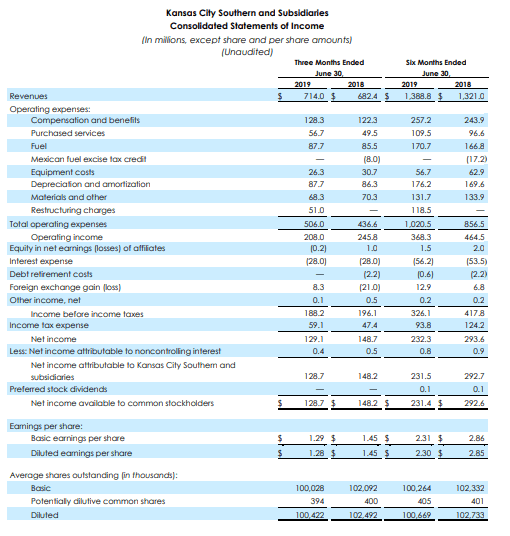UPDATE – includes comments from the second quarter earnings call
Kansas City Southern (NYSE: KSU) achieved record second quarter revenue despite flat volumes.
The railroad said second quarter revenue totaled $714 million, a 5 percent increase from $682 million for the same period in 2018. A 19 percent increase in chemicals and petroleum revenues due to the growth in shipments related to Mexico energy reform contributed to KCS’ second quarter revenue increase, as did a 5 percent increase in automotive revenues.
“The company is handling the same volume as last year with fewer assets, fewer crewstarts and considerably less network congestion, driving an improvement in customer service, operating metrics and cost profile,” said KCS chief executive officer Patrick J. Ottensmeyer. “This improvement in cost profile helped us absorb a 130 basis point headwind to our adjusted operating ratio from the loss of the Mexican Fuel Excise Tax credit, while still improving profitability versus prior year.”
Reported net profit was $129 million, or $1.28 per diluted share, in the second quarter of 2019, compared with $148 million, or $1.45 per diluted share, in the second quarter of 2018.

Because of its exposure to cross-border operations into Mexico, the company offered adjusted financial figures to account for the impact of changes in foreign currency exchange rates and adjustments to the 2017 provisional income tax benefit for the Tax Cuts and Jobs Acts, among other factors.
Taking those factors into account, reported adjusted diluted earnings per share was $1.64 in the second quarter of 2019, a 6 percent increase from the same period a year ago.
Operating income was $208 million in the second quarter, while adjusted operating income was $259 million. The latter figure excludes restructuring charges related to KCS’ deployment of precision scheduled railroading (PSR), an operating model that seeks to streamline operations and schedules. In contrast, operating income in the second quarter of 2018 totaled $245.8 million.
Reported second quarter operating expenses were $506 million, or $455 million if excluding restructuring changes related to PSR. In contrast, operating expenses in the second quarter of 2018 were $436.6 million.
The reported second quarter operating ratio was 70.9 percent, or an adjusted operating ratio of 63.7 percent. In the second quarter of 2018, the operating ratio was 64 percent. Operating ratio, which is a figure that can gauge the profitability of a railroad, is calculated by dividing operating expenses by revenues.
“I am extremely pleased with the commitment, enthusiasm and cross-functional teamwork that my Kansas City Southern colleagues have demonstrated in the early stages of executing Precision Scheduled Railroading principles,” Ottensmeyer said. “Together we are building a more consistent, reliable and resilient network that is positioned to deliver excellent customer service and strong operating leverage as volume and revenue growth improves.”
Looking at the second half of the year
As the company looks at the second half of 2019, KCS expects favorable conditions for its chemical and petroleum, and automotive segments to help boost company revenues. But loosening truck capacity could make trucks a more attractive option for intermodal shippers as well as pulp and paper product shippers.
“We’re going to need truck capacity to tighten up” in the U.S. domestic intermodal market, KCS chief marketing officer Mike Naatz said during the company’s second quarter earnings call. Kansas City Southern also said it was monitoring ongoing trade developments for potential impacts to industrial and consumer volumes.

For the second half of 2019, the railroad also hopes that measures to match rail capacity with flat demand as part of its broader efforts to implement precision scheduled railroading will also result in cutting company costs. The railroad seeks to reduce train starts and redesign the network, which can result in other outcomes such as fewer locomotives, railcars and crews.
Kansas City Southern seeks to reach annual goals of 21 hours for terminal dwell and 14 miles per hour for gross velocity for 2019. In the second quarter, average terminal dwell time was 21.2 hours, an 11 percent decrease from the same period in 2018. Average gross velocity rose 9 percent to 12.5 miles per hour in the second quarter, compared with 11.5 miles per hour for the same period last year.
“We still feel like we’re fairly early on and have room to improve further,” Ottensmeyer said in reference to how PSR could result in lowering KCS’ operating ratio.











